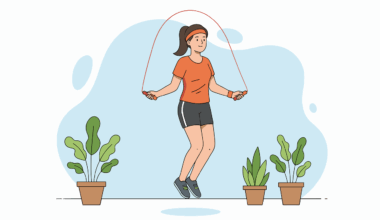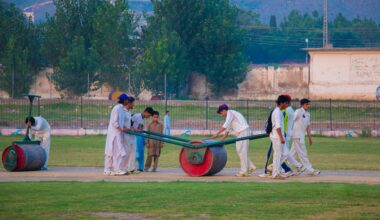Incorporating Balance Challenges in Team Sports Training
In team sports, balance is essential for optimal performance. It enables athletes to maintain stability while executing complex movements. Incorporating balance challenges in training not only enhances physical capabilities but also improves players’ overall coordination. Teams can experience several benefits through structured balance training sessions. For instance, balance challenges can reduce injury risks by strengthening stabilizing muscles, which are often neglected in traditional strength training. These exercises specifically engage core muscles, which are pivotal for maintaining body control. During drills, focus should be kept on progressive difficulty levels to keep athletes engaged and challenged. Incorporating elements such as unstable surfaces, dynamic movements, and multi-directional tasks can be particularly effective. Teams should devise a robust plan for balance training, ensuring that it aligns with overall athletic goals. Coaches can encourage players to track their improvement, fostering a competitive spirit and personal accountability. Integrating balance challenges into various practice routines not only develops athletes physically but also cultivates their mental focus, essential for peak performance in competitive environments. These adventures reveal the fun side of sports training while bolstering teamwork and mutual support among players.
Continuing on the importance of balance challenges, athletes can select a variety of exercises tailored to different sports. For example, soccer players might focus on single-leg stances while simultaneously controlling a ball. Basketball players may benefit from lateral hops to improve their proficiency during defensive maneuvers. Stretching can incorporate balance elements, allowing for improved flexibility while maintaining structural integrity. All athletes, regardless of the sport, should embrace balance as a fundamental skill. Effective balance exercises alleviate reliance on strength alone, allowing athletes to become well-rounded performers. Coaches can explain the significance of balance in gameplay situations to enhance understanding. Moreover, fostering an environment of teamwork encourages peer support during balance challenges. Partnering athletes for certain drills can increase motivation and enhance competitive energy. Adding friendly competitions within balance activities may result in positive engagement. A brief obligatory explanation of how balance impacts various mechanics is vital to ensure athletes understand the purpose behind the drills. Balancing education with practice makes routines more rewarding. Furthermore, incorporating progressive goals and challenges will ensure athletes stay focused and committed to improving their performance levels.
Types of Balance Exercises
The variety of balance exercises available can suit different training needs. For example, team exercises can include the use of balance boards, stability balls, or BOSU trainers. Balance boards are excellent for improving proprioception, which is key in injury prevention. Stability balls allow for a range of exercises. Teams can perform push-ups and squats while balancing, elevating overall assessment. Practicing on rigid and time-tested platforms ultimately results in greater muscle activation. Another engaging option involves clients capturing objects while balancing on one leg, simulating real-game conditions. When athletes engage on-field situations, dynamic balance exercises become an effective strategy. Jumping drills that focus on landing balance are practical. Logically, these exercises can replicate movements commonly encountered in competition. These types of balance challenges reinforce proprioceptive feedback directly from successful landings. Additionally, progressively adding weights to the equations can boost performance further. Maintaining high engagement levels during practice sessions fosters athlete persistence while delivering noticeable results. Set specific goals during these practices to measure progress. Develop a system for feedback collection to help athletes stay informed about their improvements and established objectives.
Incorporating technology into training regimens can augment balance challenge sessions. Many teams now utilize video analysis to observe athletes’ performance during balance challenges. Playback can help coaches spot areas for improvement, enhancing the quality of feedback. Athletes can learn about their center of gravity during practiced movements, allowing them to develop strategies to maintain balance. Emphasizing the technical side nurtures skill development while fostering analytical skills. Utilizing resources like online platforms can provide teams with access to various balance drills. Coaches can integrate these digital resources into their training plans. The creative incorporation of gamification into practice reinforces engagement, captivating young athletes while keeping focus. Moreover, making practice enjoyable requires varying balance challenges regularly. Slowly, this method will become habitual among team culture. Engage athletes in selecting challenges to increase ownership and excitement during practice. Outside practices, teams can also share their experiences through team-building exercises or social events. Relating stories or successes from practice can bolster team spirit. Gradually shifting the motivation culture can enhance commitment to pursuing balance training systematically.
Monitoring and Assessment
Regular assessment of balance challenges can inform coaches and athletes about improvement over time. Implementing a system to track progress can maintain motivation and accountability. Coaches should establish baseline measures for each athlete to properly gauge improvements. Simple assessments such as the single-leg balance test can be utilized to measure stability improvements over time. Documenting results helps visualize progress visually. This corresponds to an athlete’s physical development alongside their balance capability. Another valuable assessment method is through timed agility drills, which can provide insights into balance performance during quick directional changes. Forming partnerships for peer evaluations during practice can allow athletes to honestly assess each other’s improvements. Constructing a reward system encompassed around achieving personal milestones can also enhance team unity. Evaluative sessions create opportunities to stimulate competition, alongside allowing athletes to reflect on their training achievements. Frequent assessments alongside retention strategies ensure balance training stays effective and relevant to each athlete’s development. The ability to adapt exercises continuously based on assessment results guarantees not merely ongoing growth but excitement for challenge achievement.
Furthermore, incorporating balance challenges fosters greater mental resilience in athletes. Challenging yourself physically translates to enhanced psychological stability, enabling players to manage stress effectively. This translates remarkably to team dynamics. When players experience heightened resilience, they create stronger team bonds by relying on one another for support. Building mental toughness, facilitated through balance training, yields benefits during crucial competition moments. Teams that consistently work on balance challenges will likely handle pressure during games better. Practicing balance can also help enhance focus and attention, critical traits in high-stakes environments. As athletes learn to maintain their focus while managing physical challenges, they heighten their mental acuity simultaneously. Strengthening these mental aspects correlates to improved performances during competitions. Developing better focus allows for quicker reaction times and better decision-making during gameplay. Moreover, the shared experience of overcoming challenges unites team members, reinforcing collective goals. Gradual progress in these exercises creates a system of mutual support, further bonding athletes over shared struggle. Establishing this environment ultimately shapes a culture of resilience and perseverance, vital for any successful team. Such environments create unified teams, poised for success under pressure.
Conclusion
In summary, incorporating balance challenges into team sports training offers a multitude of advantages. From enhancing athletic performance to fostering team cohesion, balance training addresses both physical and psychological needs. Engaging athletes in diverse balance exercises can deepen not only their skill set but also their understanding of overall athleticism. Teams should prioritize consistency among balance challenges during training sessions to experience measurable growth. When implemented effectively, balance challenges become invaluable components of an athlete’s development journey. By developing techniques that promote stability, agility, and focus, athletes will cultivate skills needed on and off the field. The overall journey cultivates an environment of shared educational growth, empowering each player to contribute positively toward their team. Furthermore, by tracking progress and utilizing technology, teams can enhance engagement and motivation. As athletes witness their growth firsthand, they feel inspired to embrace further challenges ahead. It is hoped that overcoming these barriers will ultimately translate into higher performance levels during competitions. Acknowledging the integral role of these challenges prepares teams to thrive in competitive settings, fostering excellence collectively. Ultimately, maintaining balance cultivates the foundation for success in team sports.
The integration of balance challenges transforms athletic training profoundly. By fostering adaptability in athletes, they develop a keen sense of the game that few structured drills offer. These methods, as explored throughout this article, establish a stronger ecological understanding of the athletes’ unique movements. Crucially, balance challenges should be seen as an enjoyable aspect of training rather than a chore. By promoting creativity in practice, athletes will naturally gravitate toward balance exercises. This enjoyment nurtures a long-term appreciation for physical fitness beyond mere athleticism. Coaches should strive to create a culture that celebrates improvement, development, and teamwork. Ultimately, successful teams recognize that their journey transcends individual accomplishments, bringing them together toward shared objectives. Every improvement reinforces the collective spirit, driving motivation and fostering resilience. Beyond the confines of traditional training methods, balance challenges offer avenues for continuous growth and collaboration within teams. Every athlete is encouraged to take command over their challenges. Therefore, a balance of competitive spirit and teamwork will ensure sport is a positive aspect of their lives. As teams ascend through their journey, they will discover new heights of performance capabilities, armed with a strong foundation in balance and stability.


